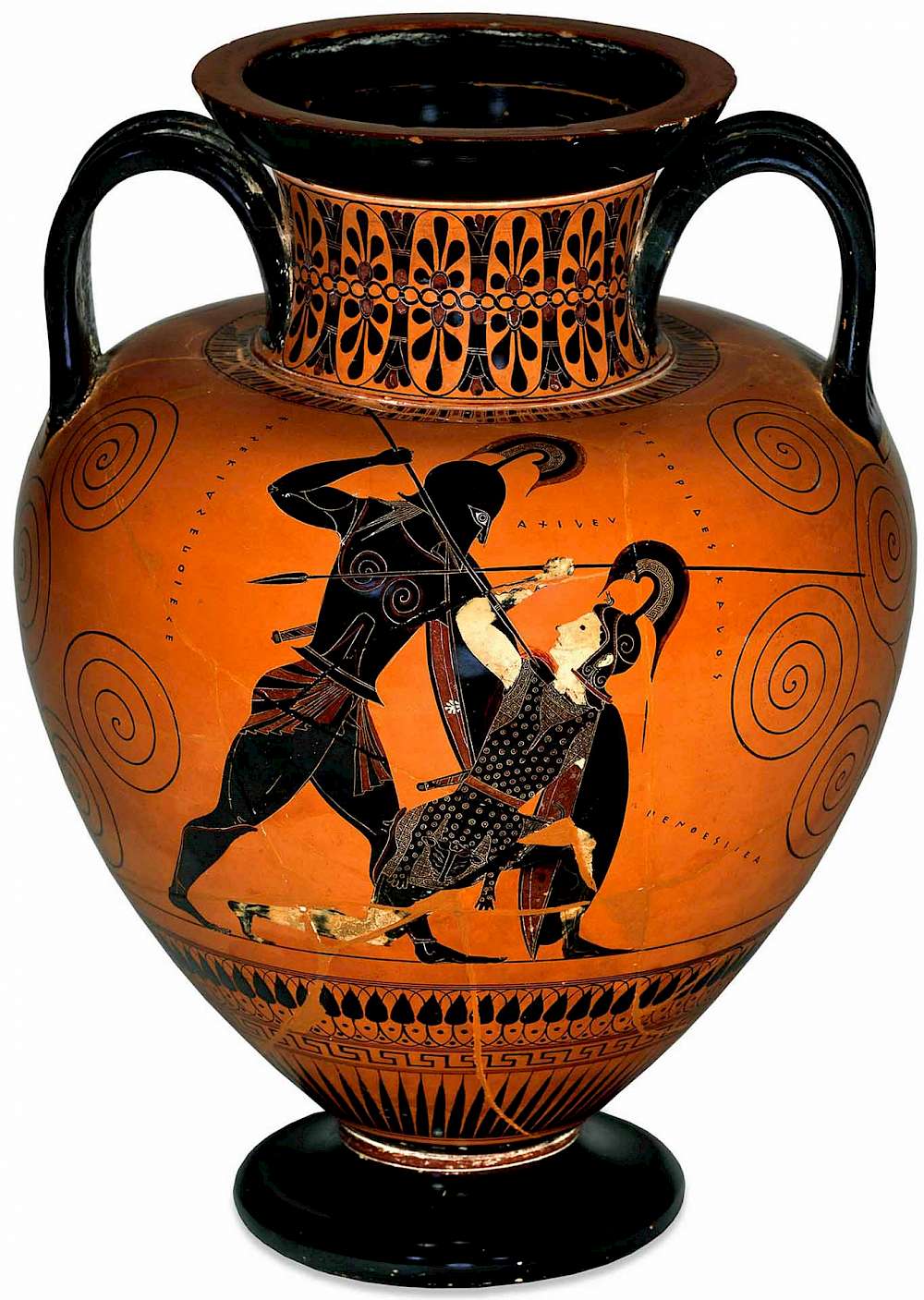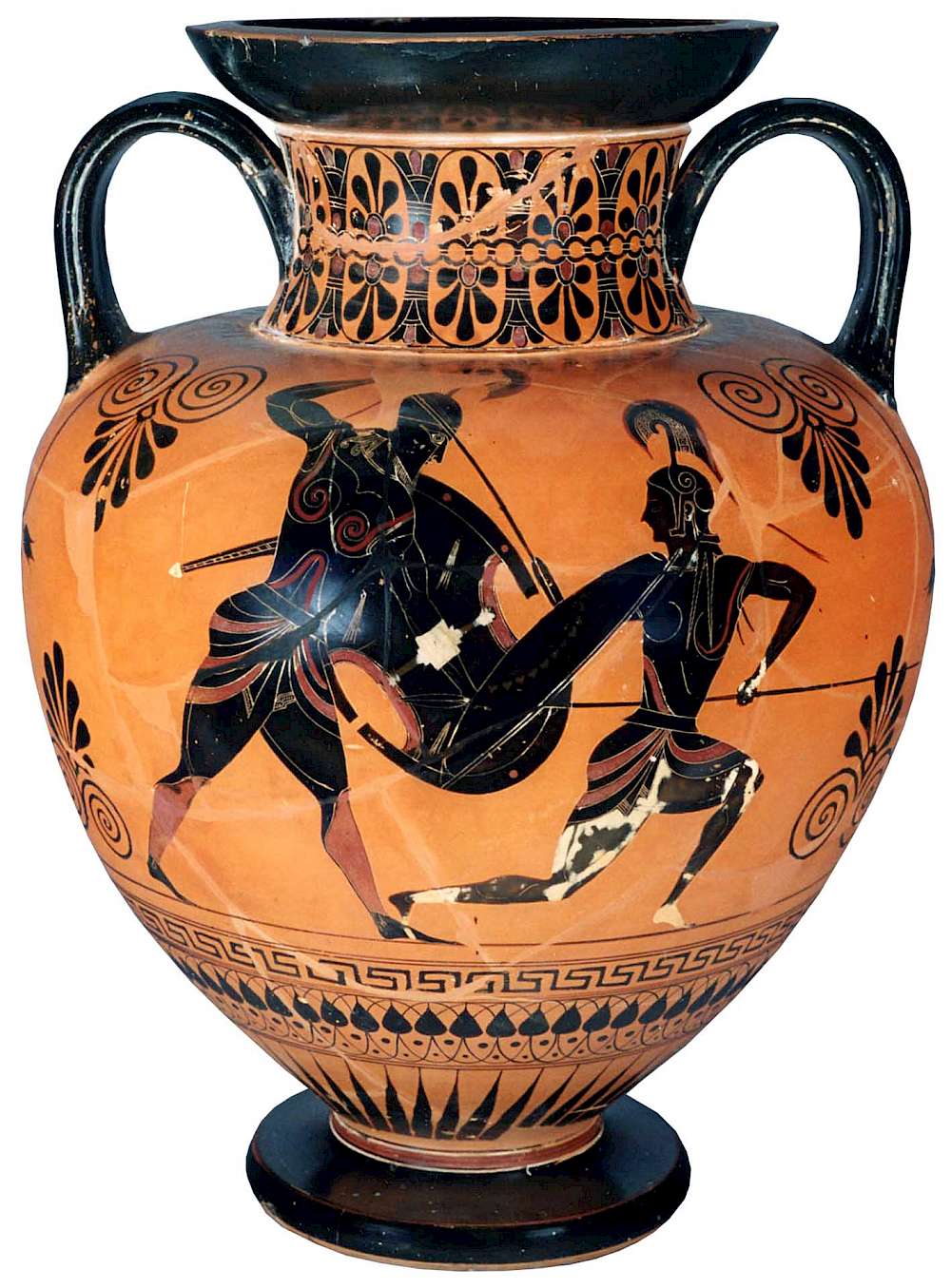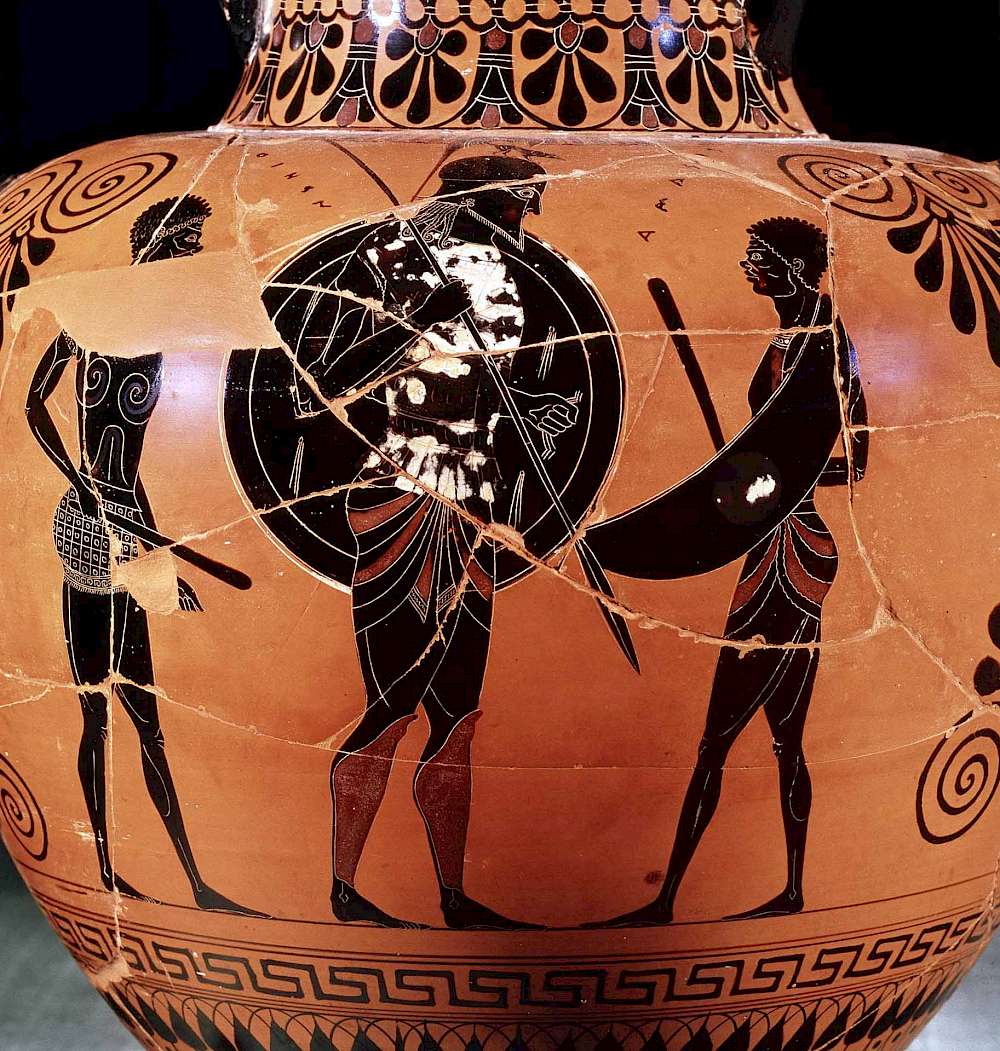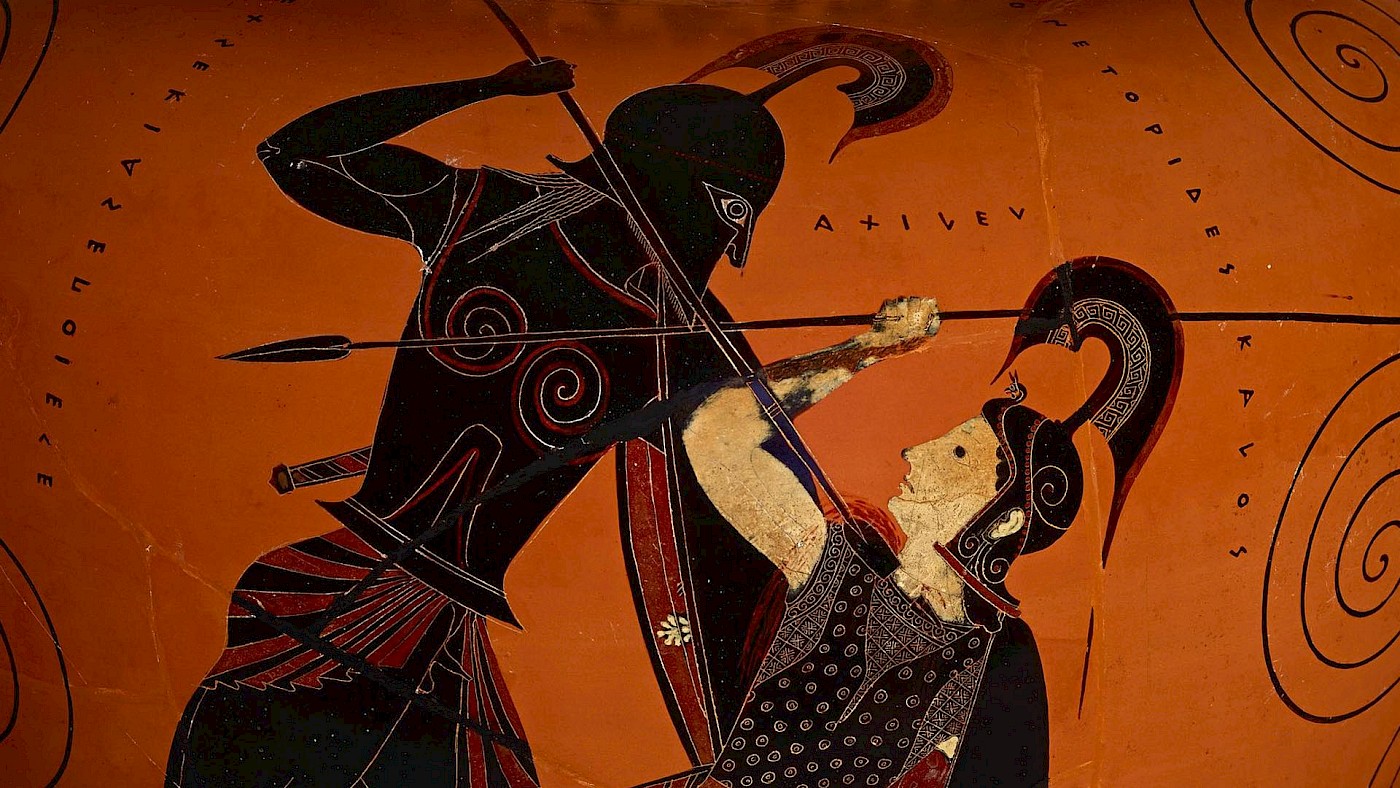The style of vase painting that we call black-figure was developed in Corinth in the seventh century BCE, but came into its own in the sixth when it was embraced by the painters of Athens. The technique takes its name from the method of painting figures in black silhouette, which contrasts with the lighter colour of the clay. Other colours might be added, such as white for women’s skin and red for blood. Into these black figures, details were scored with a sharp tool in a process called incision, probably learned from metal working.
The Athenian painter Exekias has been described as the greatest black-figure vase painter; he is certainly one of the best known. He is perhaps less well known to the modern world as a potter, and yet he signed only two vessels as painter, both of which he also signed as potter (Exēkías égrapse kapoíēsé me, “Exekias painted and made me”). An additional ten known vessels are signed with his name as potter only (Exēkías poíēsé, “Exekias made me”). John Boardman suggested that his significance in this history of Athenian art might have been as much connected to his potting as his painting, attributing to him the development of a type of cup and a type of belly amphora, as well as the invention of the calyx krater (Boardman 1991, pp. 56-57).
While Boardman’s arguments are very speculative, we are on more solid ground with other information about Exekias. The vessels he signed allow us to make some judgments regarding his style and technique, as well as perhaps his development as a painter. He seems mostly to have decorated large vessels and to have potted smaller cups for others in his workshop.
Perhaps his most famous work, a neck amphora showing Ajax and Achilles playing a game between battles at Troy (Vatican 344) – one of those which he signed as both potter and painter – is illustrative of the emergence in Athenian black-figure of the mid-sixth century of a focus on a single significant scene. While earlier vessels such as the François Vase (ca. 570-560 BCE) by the potter Ergotimos and painter Kleitias were covered with hundreds of human and animal figures – two-hundred and seventy on the François Vase – by the time Exekias was working the focus was on a single scene with as few as one or two figures.
On the Vatican amphora the decorative panel sits midway up the vessel on each side, crossing the shoulder and up to the neck, with most of the rest of the vessel painted matte black – reserved decoration above the foot, on the handles, and on the rim. This draws the eye to the scene: a moment of tension between the two players, who sit in their armour holding a pair of spears, awaiting the resumption of combat. On this vessel the contrasting colours of black paint and red clay are used to full effect to draw the eye where Exekias wanted it.
While it is impossible to be certain, the accomplished composition of the Vatican amphora may indicate that it is a mature work by Exekias. The matte-black painting, which encourages the viewer to focus on the scene, may be another indication of this maturity. Therefore, a neck-handled amphora in the British Museum signed by Exekias as potter, and attributed to him as painter, is believed to have been an earlier work.
Achilles in love?
On the one side of this vessel is a scene from the epic Aithiopis, which tells the story of the Trojan War following on from the events of the Iliad. Besides the Iliad and Odyssey, the poems of the Epic Cycle have been lost. Our knowledge of them rests primarily on a summary of the poems by one Proklos, and another summary by the Byzantine bishop Photios in the ninth century CE, which was based on the earlier summary by Proklos rather than the epics themselves. While this Proklos was probably the fifth century CE Neoplatonic philosopher, it is also possible that he was the second century CE tutor of Marcus Aurelius. In any case, his summary is believed to have been based directly on the epics, and includes several quotations from them.
The Aithiopis followed on almost immediately from the events of the Iliad. Indeed, one ancient annotator of the Iliad references an alternative final line to the poem in which “the Amazon”, Penthesileia, appears at the funeral of Hector, directly leading into the Aithiopis. Achilles, back on the battlefield, must be prevented from entering the walls of Troy and so new opponents appear to frustrate him after the death of Hector. According to the summary of the Aithiopis, Penthesileia was Thracian as well as an Amazon, and the daughter of the god Ares. She fought bravely for the Trojans until Achilles killed her.
The fight between the Achaian and the Amazon is known on shield bands from Olympia from the later seventh century, but Exekias is the earliest known vase painter to have depicted it with any certainty, ca. 540 BCE. The figures on this vessel form an almost triangular composition: Achilles’ leg and back lean over the Amazon, his spear angles down at her throat, her leg stretched back, the lower vertices. Penthesileia’s spear crosses that of her killer, creating an X that draws the eye to Achilles’ helmeted head and steely gaze. The Achaian hero wears a Corinthian helmet and bell cuirass, while Penthesileia wears a chiton with a leopard skin over it that may suggest her connection to Thrace. Both carry the double-grip aspis shield. With no other figures around, the focus of the image is entirely on the fatal action.

A familiar aspect of this story is that Achilles fell in love with Penthesileia as he killed her, but from what we know of the Aithiopis his feelings may not have been clear. According to the surviving summary, the ugly Greek Thersites mocked Achilles for being in love with the Amazon, so Achilles killed him in anger and had to go to Lesbos to be purified by Odysseus. Pseudo-Apollodoros seems to have believed Thersites’ accusations in the second century CE, as does the Latin poet Propertius in the first century BCE (3.22.15-16), but these may simply be alternative versions of the myth, or misunderstandings of what the Aithiopis said.
It is unclear, then, if we should read Exekias’ scene as showing the Greek hero falling in love with the Amazon as he kills her. While their eyes, like all eyes in Archaic Greek art, are frontal, their eyelines still seem to meet as Achilles looks into the face of his victim. However, this may be a pose of utter dominance: Achilles’ face and body are encased in his armour, showing no emotion; he towers over the fallen Amazon, who twists her body to defend herself, her shield beneath her, her spear pointing in utterly the wrong direction. Achilles’ spear pierces her throat, the red paint of her blood contrasting with the white of her flesh.
But behind the Amazon there is a clue that Exekias may have had love on his mind in this picture. Here, we can read an inscription stating ONETORIDES KALOS – “Ontorides is good”. Such kalos inscriptions have been associated with pederasty, and may thus invoke an eroticism that stikes the modern viewer as dark. On the other hand, the same inscription appears on Vatican 344, in the scene of Ajax and Achilles playing a game, and so it may indicate no such thing at all.
The Aithiopis, continued
This is not the only depiction of Achilles and Penthesileia in combat attributed to Exekias – it is not even the only one in the British Museum. Another neck-handled amphora of near identical shape shows the battle on more equal footing. The Achilles on this vessel is in a near-identical pose to the figure on the other, except that he now carries the so-called Boiotian shield: similar to the aspis, but with scallops taken from the sides reminiscent of the earlier Dipylon shield from Late Geometric vase painting.

Penthesileia, meanwhile, turns to face the hero – her legs face away from him, but her torso and upper body are turned the other way. Her shield, an aspis, rests on her shoulder, deflecting Achilles’ blow, while her spear points at his belly. On this vessel, she wears the same bell-cuirass as Achilles, with a short tunic beneath it.
This vessel has been dated slightly earlier than the one discussed above, to ca. 535-530 BCE, presumably in part because it does not appear to be as accomplished a composition as the other vessel. If we believe that they are by the same artist – and there are reasons to doubt such attributions – then it is reasonable to suggest this vessel might be an earlier work, although we are left with the question why he chose to show the figures in battle, but not the Amazon’s death as he would later. The artist named neither these figures, nor themselves, on this vessel, allowing doubt to creep in. It is possible that this is simply a battle between a warrior and an Amazon, following standard composition for such encounters.
However, there are reasons to believe the identification of the myth, at least. On the other side of this vessel stands another armoured warrior with an aspis and spear, accompanied by two attendants that we would identify in modern terms as Black men. The warrior has been identified as Memnon, the leader of the Aithiopians – hence Aithiopis – and the second defender faced by Achilles in the lost epic, after his return from Lesbos.
The vessel as a whole would thus allude to much of the story of the Aithiopis. Memnon was the son of Eos (Dawn) and Tithonos, who came from Ethiopia to fight for the Trojans. He killed Nestor’s son Antilochos (Od. 3.108-12, 4.186-88), and was said to be the most beautiful man at Troy (Od. 11. 522). After Achilles killed him, Eos asked Zeus to make her son immortal, which Zeus granted. The final act of the Aithiopis, missing from this vessel, is the death of Achilles himself at the hands of the Trojan prince Paris.

What is perhaps more interesting about this vessel is that one of the attendants is labelled “Amasis”, the Hellenized version of the Egyptian name Ahmosis. This was the name of a Pharaoh who ruled Egypt from 570 to 526 BCE, but also of a contemporary potter in Athens at the same time as Exekias. Was Exekias representing his contemporary as one of Memnon’s attendants?
It is possible that the potter received the name “Amasis” because his father was the guest-friend of an Egyptian, as sons were often named for such encounters (Herman 1987, pp. 19-21). However, this would not explain why Exekias depicted him as an Ethiopian, in which case he may have been an immigrant or descendant of immigrants from Africa, perhaps specifically Egypt (Snowden 1970, pp. 16-17).
A painter, associated with vessels signed by Amasis as potter, is known as the Amasis Painter, but it is often speculated that potter and painter are one (Boardman 1991, p.54). Boardman noted that in the ancient world, people seem to have been more preoccupied with potters, or the owners of pottery studios, than with the painters of vessels – hence the greater number of signatures of potters than of painters. As such, it is not so surprising that we find so few signatures of Exekias as painter compared to those as potter. In Amasis, we may also have a parallel for those vessels potted by Exekias and attributed to him as painter – a potter-painter emphasising one part of their work but not the other.
Final thoughts
If the painter of the Memnon amphora is truly referencing another Athenian potter/painter, we have to wonder how such choices would have been received in the Italian/Etruscan context in which these vessels were discovered. As Najee Olya has pointed out, the Etruscans were themselves “Other” in Greek eyes, and may not have read the Egyptian Amasis or the leopard-skin wearing Penthesileia in the same way as the Athenian who painted them.
Indeed, it is fair to say that there are numerous ways of interpreting any ancient vase painting, just as there are of interpreting any work of art and literature, ancient or modern. We may see the eye contact between Achilles and Penthesileia as he kills her as indicative that he is falling in love, or we may read it as a brutal act of violence against a woman indicative of a misogynistic culture. Frank M. Snowden noted that earlier scholars considered Exekias’ labelling of Amasis a humorous caricature, a common trend in modern interpretations of Black bodies in ancient art.
Would an ancient audience have connected this vessel to the Aithiopis? It is unclear to us when this poem, and the rest of the Epic Cycle, crystalized – it may not have been before the Hellenistic period (323-31 BCE), although there are references to a “cycle” as early as Aristotle in the fourth century. Nevertheless, it is clear that by the sixth century, the further adventures of Achilles at Troy were known to the painters of Athens.
Further reading
On Exekias and Amasis:
- John Boardman, Athenian Black Figure Vases: A Handbook (1991), pp. 54-58.
- Elizabeth Moignard, Master of Attic Black-Figure Painting: The Art and Legacy of Exekias (2015).
- Frank M. Snowden, Blacks in Antiquity: Ethiopians in the Greco-Roman Experience (1970).
- Mark Stansbury-O’Donnell, A History of Greek Art (2015), pp. 205-206.
On the story of Penthesileia, Memnon, and the Aithiopis:
- Joel P. Christensen, “Epic Cycle”, in: Corrine Ondine Pache (ed), The Cambridge Guide to Homer (2020), pp. 118-119.
- Beth Cohen, “The non-Greek in Greek art”, in: Tyler Jo Smith and Dimitris Plantzos (eds), A Companion to Greek Art (2012), pp. 456-479.
- Timothy Gantz, Early Greek Myth: A Guide to Literary and Artistic Sources (1993), pp. 621-625.
- Jim Marks, “Epic Traditions”, in: Corrine Ondine Pache (ed), The Cambridge Guide to Homer (2020), pp. 49-61.
Further references:
- Gabriel Herman, Ritualized Friendship and the Greek City (1987).
